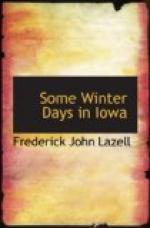* * * * *
Why did Bryant dwell so often on the theme of death in Nature? The reminders of death are very few compared with the signs of life. Break off a twig from the aspen and taste the bark. The strong quinine flavor is like a spring tonic. Cut a branch of the black cherry, peel back the bark, and smell the pungent, bitter almond aroma, which of itself is enough to identify this tree. Every sense tells of life; the smell of the cherry, the taste of the aspen, the touch of the velvety mosses and the gummy buds on the poplars, the color of the twigs and buds, the music of the birds, all these say, “There is no death.”
Every time you plant your feet upon the snow you press down thousands of seeds, minute forms of life, each with its little store of starch or albumen, carefully compounded in Nature’s laboratory, sufficient to sustain the embryonic life until the tiny plantlet learns to draw nourishment from the breast of Mother Earth and to breathe health and vigor from the sunshine and the air. By the wayside, in stony places, among thorns and on good ground, Nature sows her seeds with lavish hand. Every tree and shrub and herb, itself held fast to one place, tries to give its offspring as great a start in the world as possible. Even in late February one may see some of Nature’s airships, designed to carry seeds. They are all built on the same principle, not to rise in the air, but to fly as far away from the tree as possible when falling from the branch. The basswood puts its seeds into little hollow wooden balls, then makes a sail out of a leaf and sets it at just the right angle to balance the seeds and catch the breeze. The winged samaras of the ash and the box elder are other modifications of the same principle. The round balls of the sycamore hang till the high winds of March loosen their strong stalks and then they break open and the club-shaped nutlets inside spread their bristly hairs to the breeze. The hop-like strobiles of the hop hornbeam seem especially made to blow over the surface of the frozen snow; they drop off the queer little oblong bags as they go and thus the smooth small nuts inside are planted. The oaks, hickories, walnuts, butternuts, hazelnuts, trust their fruits to the feet of passersby and to the squirrels and blue jays which fail to find many of their buried acorns




